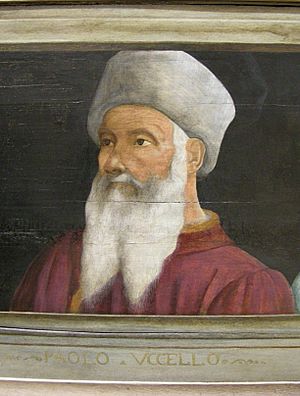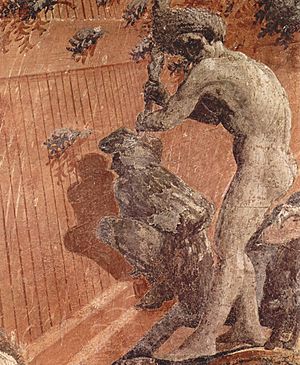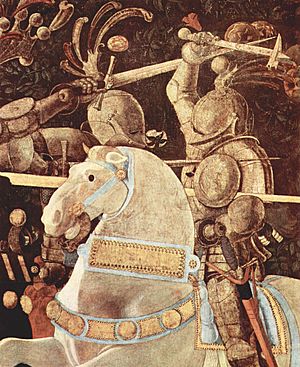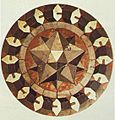Paolo Uccello facts for kids
Quick facts for kids
Paolo Uccello
|
|
|---|---|

Portrait of Paolo Uccello (unknown artist),
Louvre Museum, Paris |
|
| Born |
Paolo di Dono
December 10, 1397 Pratovecchio, Republic of Florence
|
| Died | 10 December 1475 (aged 77–78) Florence, Republic of Florence
|
| Nationality | Italian |
| Education | Lorenzo Ghiberti |
| Known for | Painting, fresco |
|
Notable work
|
Funerary Monument to Sir John Hawkwood, Saint George and the Dragon, The Battle of San Romano |
| Movement | Early Renaissance |
Paolo Uccello (born around 1396, died 1475) was a famous painter from Florence, Italy. He lived during the Early Renaissance period. Paolo Uccello is well-known for being one of the first artists to use perspective in his paintings. This made his art look more real and three-dimensional.
Most of what we know about Uccello comes from Giorgio Vasari. Vasari wrote a biography about Paolo Uccello many years after he died. Paolo Uccello was born in Florence around 1396. Vasari said he was called Uccello, which means "Bird". This was because he loved all animals, especially birds, and often painted them.
When Paolo was about 11 years old, he began training. He worked in the workshop of Lorenzo Ghiberti. Ghiberti was a very famous artist in Florence. He had won a big competition to make beautiful bronze doors for the city's oldest church. These doors took 27 years to finish. Many artists helped, and many young people like Uccello learned there. Uccello worked with Ghiberti for eight years.
Contents
Early Art Projects
While Uccello was still young, he got an important job. He was asked to paint frescoes for the monks of San Miniato. This church was on a mountain above Florence. The frescoes were meant to show stories of different saints.
The monks at the monastery ate very simple food. They only ate bread and cheese. So, Uccello also ate only bread and cheese for every meal. After a few weeks, he felt like he was turning into cheese! He left the monastery and went back to Florence. His work was not finished.
One day, two monks found Uccello in Florence. They asked him why he had not finished the job. Uccello told them it was because of the cheese. The monks laughed. They promised him better food if he would return and finish his work. He went back and completed the frescoes, called The Lives of the Church Fathers. Vasari said Uccello never ate cheese again after that.
Today, these frescoes at San Miniato are badly damaged. Much of the paint has fallen off or faded. However, one beautiful angel painting is still quite clear. In 1425, Uccello moved to Venice. He lived and worked there for several years.
Working at Florence Cathedral
In 1436, Uccello returned to Florence. He had important jobs to do for Florence Cathedral. His first job was to paint a large fresco to honor an English Knight, Sir John Hawkwood.
The painting of Sir John Hawkwood is quite special. It shows Sir John on his war horse. Uccello painted it to look like a statue. He used white and greenish-grey colors against a dark red-brown background. The horse's saddle and bridle are bright red, adding color. The horse stands on a painted plinth, like the base of a statue. Sir John's name is written on it. Large letters say "The Work of Paolo Uccello."
This painting was very popular. Years later, another soldier was honored in a similar way. The artist Andrea Castagno painted him.
Uccello's second job at the Cathedral was to paint the clock. The clock has two faces. One is outside in the square, and the other is inside the cathedral. Uccello painted the clock face on the inside wall. It is a 24-hour clock with only one hand. Uccello painted the round clock face into a square shape. He put the head of a prophet in each corner. The prophets' faces look very different. Uccello painted bright light and dark shadows on their faces. It looks as if the light comes from a real window high on the wall.
Another important job for the cathedral was designing two large stained glass windows. Each window was 4.5 meters across. The cathedral had a huge hole in its center that needed a roof. An artist named Brunelleschi designed a brilliant dome. Everyone in the city was excited to build it. Eight groups of workers built the eight parts of the dome. As the dome grew, it had eight large windows that needed glass. The best artists in Florence were asked to design them. Three of Uccello's designs were used. Sadly, one was broken in 1828. The two remaining windows show The Nativity (the birth of Jesus) and The Resurrection (Jesus rising from the dead).
By 1453, Uccello was married to Tomassa Malifici. In that year, they had a son named Donato. He was named after the sculptor Donatello. In 1456, they had a daughter, Antonia. She later became a nun and a painter.
The Great Flood Paintings
Some of Uccello's most famous works are frescoes of Noah's Ark and the Great Flood. These are in the Church of Santa Maria Novella in Florence. Sadly, they are quite damaged and partly lost. But even so, you can see how clever Uccello was. Two things are amazing about these pictures. First, they look very realistic. Second, they use perspective to make you feel like you are looking right into the scene.
Like the Sir John Hawkwood fresco, Uccello did not use many colors. The pictures are painted in white, pale grey, blue-grey, and a little black. The landscape is grey, and the water is blue-grey. The people are white with grey shadows. But small bits of red make the paintings lively. All the man-made things, like the Ark, old doors, barrels, and broken items floating on the water, are painted in the same red color. Some people wear big black and white hats that were popular in Florence.
In this terrible flood scene, one man floats in a barrel. Another man grabs an old man's ankles to pull himself up. A man with his hat slipped down hits the Ark's wall with a club. The wind blows, rain pours down, and branches fly. It is a scene of great fear.
The Battle of San Romano
Cosimo Medici was one of the richest men in Florence. He loved to spend money on art. He asked Uccello to paint three large pictures on wooden panels. Each was about 3 meters long. They were to decorate his palace. The paintings showed three scenes from the Battle of San Romano. In this battle, Florentine troops defeated the nearby town of Siena. It was not a very fierce battle, but it made three great pictures.
These paintings were later split up among three important art galleries. The National Gallery, London has the left scene. It shows Niccolo Tolentino leading his troops on his grand white horse. He wears a big red and gold Florentine hat. The Uffizi Gallery in Florence has the middle scene. Here, the enemy leader, Bernadino della Ciarda, is hit by a spear. He falls backward off his horse. The right-hand scene is in the Louvre in Paris. It shows the brave Michelotto di Cotignola turning his horse to attack an enemy with his sword.
At first glance, each battle scene looks messy. But the paintings are very carefully planned. This is clear in how Uccello arranged the upright spears and weapons on the ground. They all guide your eye into the painting. They create perspective. While the battle rages in the foreground, the background has mountains, fields, hedges, and woods. You can see farmers, hunters, and animals there. The different sizes of figures in the foreground and background create a sense of distance in the picture.
Uccello studied perspective his whole life. He was very focused on it. Sometimes, he would not leave his house for weeks. His friend Donatello, another respected artist, asked him to paint more and study less. Uccello became very good at calculating the perspective of buildings. But it was not until he was old that he fully understood how to calculate the sizes of things like people far away. His last painting shows a hunting party. It has a large forest, people, and dogs, all moving into the distance, from near to far.
Later Years
In 1469, Paolo wrote on his tax papers that he was too old to work. He also said his wife was ill. Giorgio Vasari, who wrote about many painters 100 years later, said that Paolo was upset by Donatello. Donatello looked at Paolo's latest painting and joked that he should cover it up. Vasari said Paolo was so hurt that he stayed in his room. He kept working on his drawings. Whenever his wife called him to bed, he would answer, "What a wonderful thing perspective is!"
Paolo Uccello died on November 10, 1475. He left behind his wife and his daughter Antonia. Antonia was also a very good painter. Sadly, none of her pictures are known today.
Other pages
Images for kids
-
Marble mosaic showing a small stellated dodecahedron and a ring of hexagonal prisms, on the floor of St Mark's Basilica, Venice
See also
 In Spanish: Paolo Uccello para niños
In Spanish: Paolo Uccello para niños










